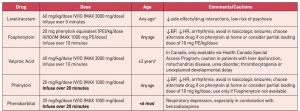Status epilepticus (peds): Difference between revisions
| Line 93: | Line 93: | ||
==References== | ==References== | ||
* EIIC-TREKK Bottom Line Recommendations Pediatric Status Epilepticus. April 2022, TREKK; EIIC; For Revision 2024. Version 1.0. https://emscimprovement.center/education-and-resources/peak/peak-status-epilepticus/eiic-trekk-bottom-line-recommendations-pediatric-status-epilepticus/. | * EIIC-TREKK Bottom Line Recommendations Pediatric Status Epilepticus. April 2022, TREKK; EIIC; For Revision 2024. Version 1.0. https://emscimprovement.center/education-and-resources/peak/peak-status-epilepticus/eiic-trekk-bottom-line-recommendations-pediatric-status-epilepticus/. | ||
* EIIC-TREKK Pediatric Status Epilepticus Algorithm. April 2022 Version: 4.0 Review date: 2024. https://emscimprovement.center/education-and-resources/peak/peak-status-epilepticus/trekk-eiic-pediatric-status-epilepticus-practice-guideline/. | |||
Revision as of 17:45, 4 October 2022
PAGE IS IN PROGRESS
Background
For a child over 1 month of age
- Categorized as convulsive or non-convulsive
- Convulsive status epilepticus: patient will have tonic-clonic movements with altered mental status, may have focal neuro deficits post-ictally (Todd's paralysis)
- Non-convulsive status epilepticus: patient will have seizure activity on EEG without clinical findings
Clinical Features
- Defined as: an unresponsive patient with either one of the following
- Seizure >5 min and/or ongoing seizure on presentation
- 2 or more seizures without full recovery of consciousness between seizures
Differential Diagnosis
- Fever, severe infection (meningitis, encephalitis)
- Anoxic injury
- Electrolyte derangements
- Hyper or hypoglycemia
- Hyper or hyponatremia
- Hyper or hypocalcemia
- Traumatic brain injury (TBI)
- Anti-epileptic drug (AED) non-adherence, overdose, withdrawal
- Toxic exposure (PLASTIC mnemonic)
- P: Pesticides, Propranolol, Phencyclidine (PCP)
- L: Lead, Lithium, Lidocaine, Lindane
- A: Alcohols, Amphetamines
- S: Sugar (hypoglycemics), Salicyclates, Sympathomimetics
- T: Tricyclic antidepressants, Theophylline
- I: Isoniazid, Iron, Insulin
- C: Cocaine, Camphor, Caffeine
- Structural abnormality of the brain
- Hypoxic-ischemic encephalopathy (HIE)
- Neurodegenerative disorder
- Stroke
- Genetic condition
Evaluation
Workup
- Check a blood glucose
- Consider an electrolyte panel, a blood gas, CBC, calcium level, LFTs
- If appropriate collect anticonvulsant drug levels
- Consider blood & urine culture
- Data for lumbar puncture routinely is not conclusive - consider it in a febrile patient with signs of meningitis or localized neuro findings (perform once patient is stabilized)
- Consider toxicology studies
- Consider EKG to evaluate for arrhythmias, toxins and electrolyte abnormalities
- May consider head imaging once patient is stabilized
Management
Phase 0 (0-5 minutes)
- ABC's
- Maintain airway; suction, jaw thrust
- Provide O2 via non-rebreather mask, 10-15 L/min
- Establish IV access, give bolus if perfusion inadequate
Phase 1 (5-15 minutes)
Prehospital
- Give Midazolam 0.2 mg/kg/dose IM/intranasal (MAX 10 mg/dose)
- Check blood glucose
- If blood glucose <3.3 mmol/L (<60 mg/dL): Treat with D25W 2 mL/kg/dose IV (MAX 100 mL/dose) OR D10W 5 mL/kg/dose IV (MAX 250 mL/dose).
- If ≥3.3 mmol/L (≥60 mg/dL): Give second dose of Midazolam 0.2 mg/kg/dose IM/intranasal (MAX cumulative dose of 10 mg in prehospital setting; if max dose given, consult Medical Director/Base Hospital for next step).
Emergency Department
- Give a benzodiazepine (if two doses not already given prior to ED arrival). Give a second dose for ongoing seizure after 5 minutes. Do not give more than two doses (apnea risk).
- With IV/IO access: Lorazepam 0.1 mg/kg/dose IV/IO (MAX 4 mg/dose) OR Midazolam 0.1 mg/kg/dose IV/IO (MAX 10 mg/dose)
- No IV/IO Access: Midazolam 0.2 mg/kg/dose IM/intranasal (MAX 10 mg/dose)
- Check blood glucose and respond as above if not already done
- Give acetaminophen 15 mg/kg/dose (MAX 650 mg) if febrile
Phase 2 (15-50 minutes)
- Give Levetiracetam, Phenytoin/Fosphenytoin or Valproic acid (equally efficacious for status epilepticus)
- Levetiracetam is preferred given quick administration, favorable side effect profile, and less drug interactions
- If still seizing 5 minutes following medication infusion, choose another second-line agent to give and contact a referral site
- Do not combine Phenytoin and Fosphenytoin
Phase 3 (50 minutes onwards)
- If two second-line therapies fail, discuss further management with Pediatric Referral Site
- Prepare for airway support given apnea risk
- Consider third-line options; continuous IV infusion of Midazolam, Pentobarbital, Propofol OR Ketamine
Disposition
- Criteria for admission
- Patients with refractory seizures
- Patients who are not responsive within 4-6 hours of arrival to the ED
- Criteria for discharge
- Patients who have returned to baseline post seizure management
- Patients whose parents/guardians feel comfortable with discharge and have been counseled about what to do if seizure recurs
See Also
External Links
References
- EIIC-TREKK Bottom Line Recommendations Pediatric Status Epilepticus. April 2022, TREKK; EIIC; For Revision 2024. Version 1.0. https://emscimprovement.center/education-and-resources/peak/peak-status-epilepticus/eiic-trekk-bottom-line-recommendations-pediatric-status-epilepticus/.
- EIIC-TREKK Pediatric Status Epilepticus Algorithm. April 2022 Version: 4.0 Review date: 2024. https://emscimprovement.center/education-and-resources/peak/peak-status-epilepticus/trekk-eiic-pediatric-status-epilepticus-practice-guideline/.



